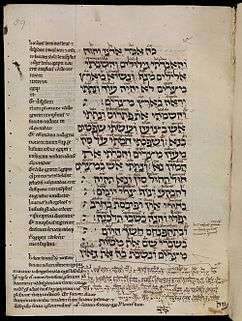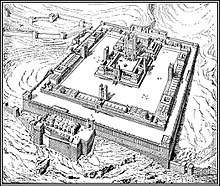Ezekiel 40
| Ezekiel 40 | |
|---|---|
 Book of Ezekiel 30:13–18 in an English manuscript from the early 13th century, MS. Bodl. Or. 62, fol. 59a. A Latin translation appears in the margins with further interlineations above the Hebrew. | |
| Book | Book of Ezekiel |
| Bible part | Old Testament |
| Order in the Bible part | 26 |
| Category | Nevi'im |
Ezekiel 40 is the fortieth chapter of the Book of Ezekiel in the Hebrew Bible or the Old Testament of the Christian Bible. This book contains the prophecies spoken by the prophet Ezekiel, and is a part of the Books of the Prophets.[1]
Text
- The original text is written in Hebrew language.
- This chapter is divided into 49 verses.
Textual versions

The visionary Ezekiel Temple plan drawn by the 19th-century French architect and Bible scholar Charles Chipiez
Some most ancient manuscripts containing this chapter in Hebrew language:
Ancient translations in Koine Greek:
- Septuagint
- Theodotion version
Structure
NKJV groups this chapter into:
- Ezekiel 40:1-5 = A New City, a New Temple
- Ezekiel 40:6-16 = The Eastern Gateway of the Temple
- Ezekiel 40:17-19 = The Outer Court
- Ezekiel 40:20-23 = The Northern Gateway
- Ezekiel 40:24-27 = The Southern Gateway
- Ezekiel 40:28-37 = Gateways of the Inner Court
- Ezekiel 40:38-43 = Where Sacrifices Were Prepared
- Ezekiel 40:44-46 = Chambers for Singers and Priests
- Ezekiel 40:47-49 = Dimensions of the Inner Court and Vestibule
Verse 1
- In the twenty-fifth year of our captivity, at the beginning of the year, on the tenth day of the month, in the fourteenth year after the city was captured,
- on the very same day the hand of the Lord was upon me; and He took me there. (NKJV)[2]
- The vision was given on the 25th anniversary of Ezekiel's exile, "April 28, 573 BCE".[3]
Verse 4
- And the man said to me,
Verse 5
- Now there was a wall all around the outside of the temple.
- In the man’s hand was a measuring rod six cubits long, each being a cubit and a handbreadth;
- and he measured the width of the wall structure, one rod; and the height, one rod. (NKJV)[6]
- "A cubit and a handbreadth": a cubit is about "44.4 cm or 17.5 in."; a handbreadth (or "four fingers thick") is about "7.4 cm or 2.9 in."[7] Epiphanius of Salamis, in his treatise On Weights and Measures, describes that: "the part from the elbow to the wrist and the palm of the hand is called the cubit, the middle finger of the cubit measure being also extended at the same time and there being added below (it) the span, that is, of the hand, taken all together."[8]
The Eastern Gateway of the Temple

Gateways of Ezekiel's Temple, as described in the Book of Ezekiel, drawn by the Dutch architect Bartelmeüs Reinders (1893–1979)
Ezekiel records the blueprint of the eastern gateway (which is similar to northern and southern gates) based on the action of the man acting as his guide:[9]
- Then he went to the gateway which faced east; and he went up its stairs and measured the threshold of the gateway, which was one rod wide, and the other threshold was one rod wide. Each gate chamber was one rod long and one rod wide; between the gate chambers was a space of five cubits; and the threshold of the gateway by the vestibule of the inside gate was one rod.
- He also measured the vestibule of the inside gate, one rod. Then he measured the vestibule of the gateway, eight cubits; and the gateposts, two cubits. The vestibule of the gate was on the inside.
- In the eastern gateway were three gate chambers on one side and three on the other; the three were all the same size; also the gateposts were of the same size on this side and that side.
- He measured the width of the entrance to the gateway, ten cubits; and the length of the gate, thirteen cubits.
- There was a space in front of the gate chambers, one cubit on this side and one cubit on that side; the gate chambers were six cubits on this side and six cubits on that side.
- Then he measured the gateway from the roof of one gate chamber to the roof of the other; the width was twenty-five cubits, as door faces door.
- He measured the gateposts, sixty cubits high, and the court all around the gateway extended to the gatepost.
- From the front of the entrance gate to the front of the vestibule of the inner gate was fifty cubits.
- There were beveled window frames in the gate chambers and in their intervening archways on the inside of the gateway all around, and likewise in the vestibules. There were windows all around on the inside. And on each gatepost were palm trees.
See also
- Related Bible parts: 1 Kings 6, 2 Chronicles 3, Isaiah 2, Ezekiel 33, Daniel 10, Revelation 21
Notes and references
- ↑ Theodore Hiebert, et al. 1996. The New Interpreter's Bible: Volume VI. Nashville: Abingdon.
- ↑ Ezekiel 40:1
- ↑ The New Oxford Annotated Bible with the Apocrypha, Augmented Third Edition, New Revised Standard Version, Indexed. Michael D. Coogan, Marc Brettler, Carol A. Newsom, Editors. Publisher: Oxford University Press, USA; 2007. p. 1238-1240 Hebrew Bible. ISBN 978-0195288810
- ↑ Ezekiel 40:4
- ↑ Bromiley 1995, p. 574.
- ↑ Ezekiel 40:5
- ↑ Bromiley 1995, p. 1048-1049.
- ↑ Epiphanius' Treatise on Weights and Measures - the Syriac Version (ed. James Elmer Dean, The University of Chicago Press: Chicago 1935, p. 69
- ↑ Ezekiel 40:6-16
Bibliography
- Bromiley, Geoffrey W. (1995). International Standard Bible Encyclopedia: vol. iv, Q-Z. Eerdmans.
- Brown, Francis; Briggs, Charles A.; Driver, S. R. (1994). The Brown-Driver-Briggs Hebrew and English Lexicon (reprint ed.). Hendrickson Publishers. ISBN 978-1565632066.
- Clements, Ronald E (1996). Ezekiel. Westminster John Knox Press. ISBN 9780664252724.
- Gesenius, H. W. F. (1979). Gesenius' Hebrew and Chaldee Lexicon to the Old Testament Scriptures: Numerically Coded to Strong's Exhaustive Concordance, with an English Index. Translated by Tregelles, Samuel Prideaux (7th ed.). Baker Book House.
- Joyce, Paul M. (2009). Ezekiel: A Commentary. Continuum. ISBN 9780567483614.
External links
Jewish
Christian
This article is issued from
Wikipedia.
The text is licensed under Creative Commons - Attribution - Sharealike.
Additional terms may apply for the media files.